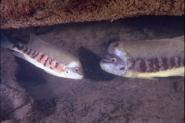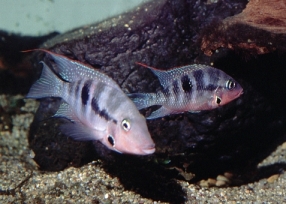| Telling Males from Females |
| Telling Males from Females |
Telling males from females is one of the most common problems a beginning cichlid hobbyist faces. For some species, males and females are readily distinguishable by color, size or shape. For others it is difficult or even impossible to tell the sexes apart in nonbreeding individuals. We call differences between the sexes "sexual dimorphism" and when there is no difference, we say they are "monomorphic". Oscars are the most monomorphic cichlids I know of, with no visual differences between males and females.
Probably the most accurate means for telling the sexes apart is a technique known as "venting", i.e. examining the vent region of a fish to determine its sex. For an excellent discussion and photographs on "venting", take a look at GARY KRATOCHVIL's page.
The most difficult part of venting is that you need to have the fish in-hand in order to look closely at the vent region. This isn't always possible.
Are there other ways of determining the sex of a fish? Yes. But, there are also many myths that must be avoided. Determining the sex also depends to a large degree on what "type" of cichlid you are looking at, e.g., Central American, West African, mbuna from Lake Malawi etc.
Central American cichlids
Using the convict cichlid as our sample organism for this group, there are several characteristics that allow you to distinguish males from females. In this group, males and females often differ from each other in body shape and size, certain aspects of coloration and occasionally in fin length.
Body shape and size. In general, in the wild, males in this group are larger than females. That is, if you find a pair in the wild, the male will be larger than the female. However, some females are definitely larger than some males, so size alone is not a perfect indicator. Females are also rounder, though this difference is easily masked by a belly full of food. Males may have nuchal humps (a hump on the forehead). The size and shape of the hump differs by species. In the wild only males appear to get humps, but in aquaria, females can get humps too, even fairly large ones. So the presence of a hump does not in itself identify a male.
A pair of Tomocichla tuba in the wild. The male is on the right. Notice the nuchal hump on his forehead. The female is displaying the full white "breeding mask" while the male's mask is only partially expressed. This pair is guarding a clutch of eggs. 
Coloration. The coloration differences between the sexes are mostly species specific, meaning that the difference between male and female of one species will not apply to another species. For example, female convict cichlids have orange on the belly, particularly when they are in breeding mode. Males lack the orange. For many species, the female changes into her breeding colors sooner in the breeding cycle than does the male. For example, tuba (Tomocichla tuba) males in Costa Rica often don't show full expression of the breeding mask until after the fry are free-swimming whereas females display the mask at spawning.
Fin length. Males often have longer, more flowing anal and dorsal fins (the ones on the bottom and top respectively). Again there are many exceptions to this and I have seen female convict cichlids with dorsal fins that extended well past the end of the tail fin. So again, the presence of long fins does not necessarily indicate a male fish.

A pair of firemouth cichlids. The male is larger and has longer fin extensions. The female is smaller and rounder, particularly in the belly region.
![[Go Back to Contents]](gifs/back.gif) |
![[Send email to Ron Coleman]](gifs/address.gif) |